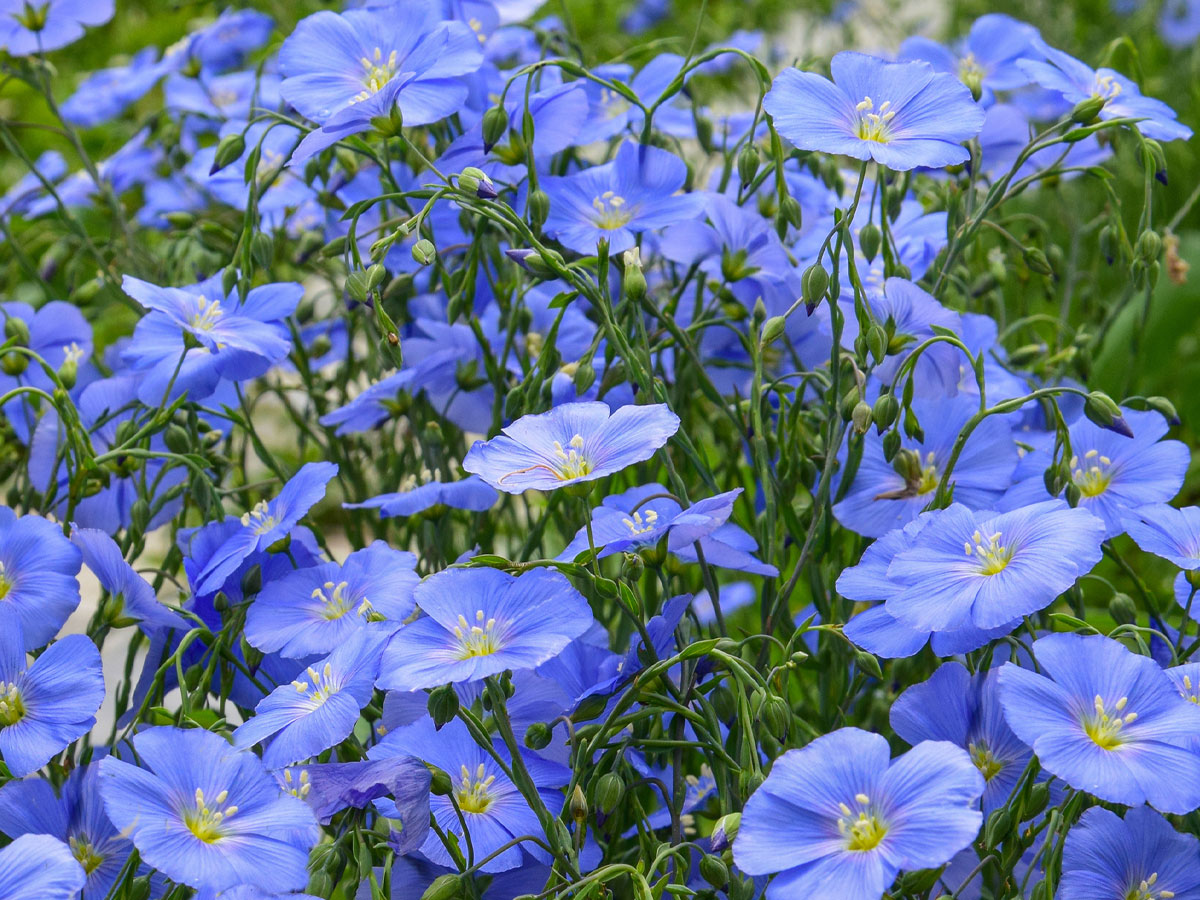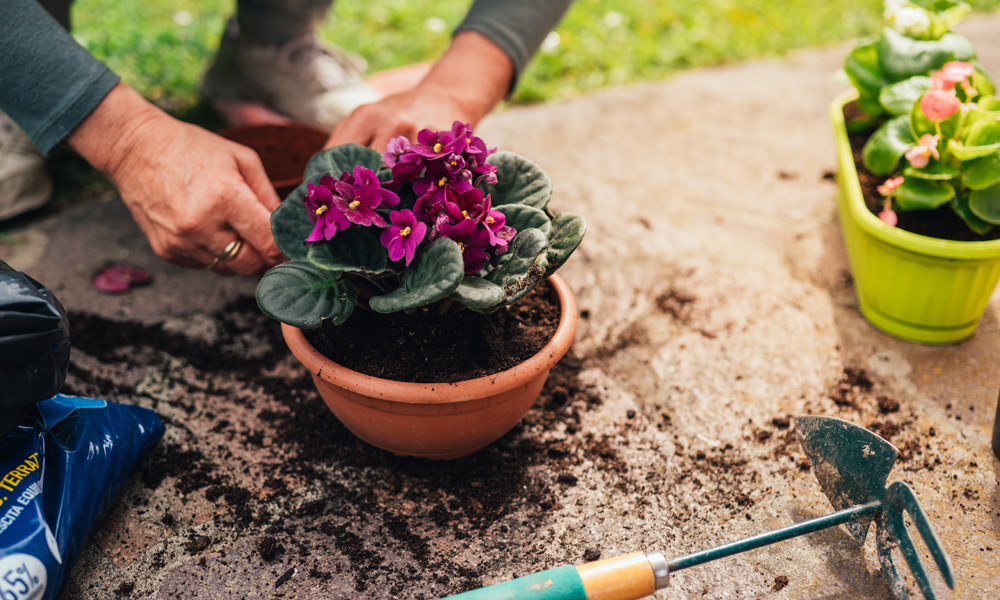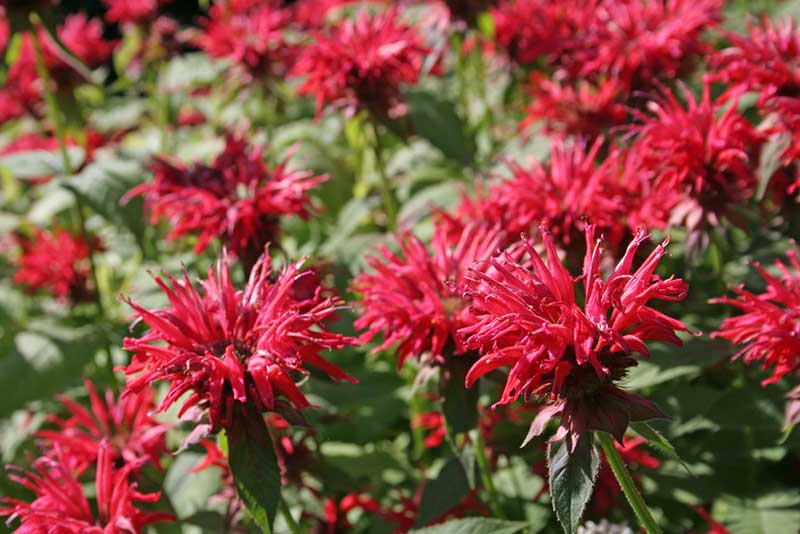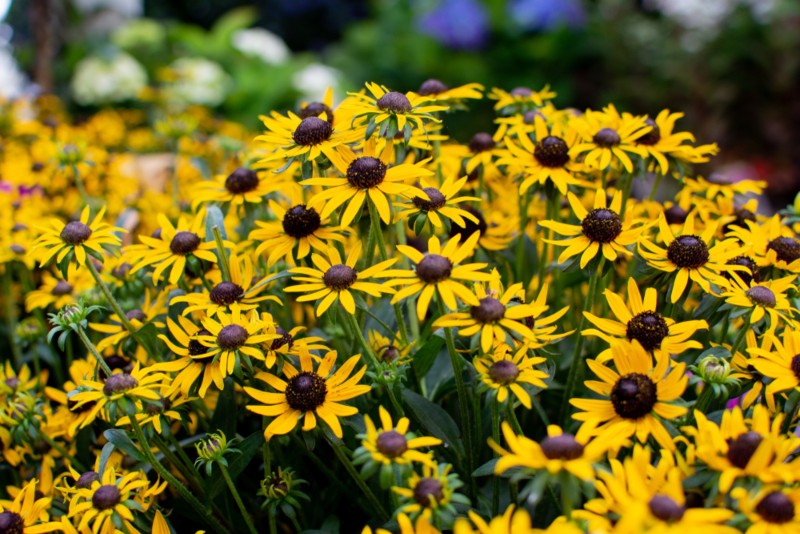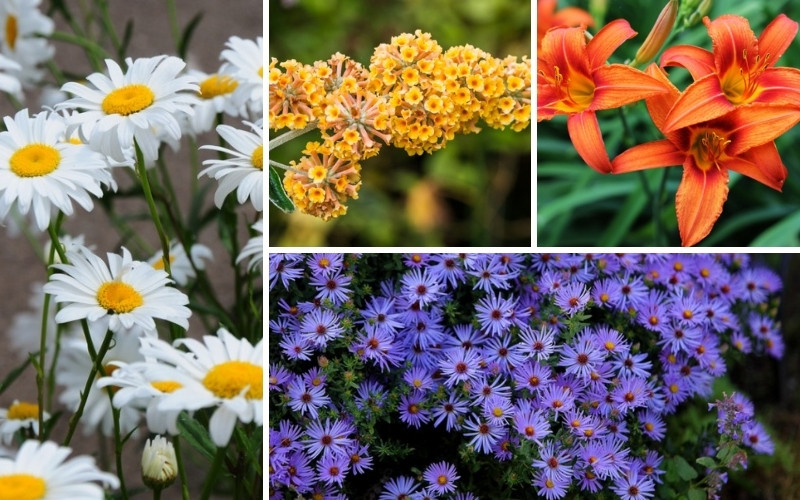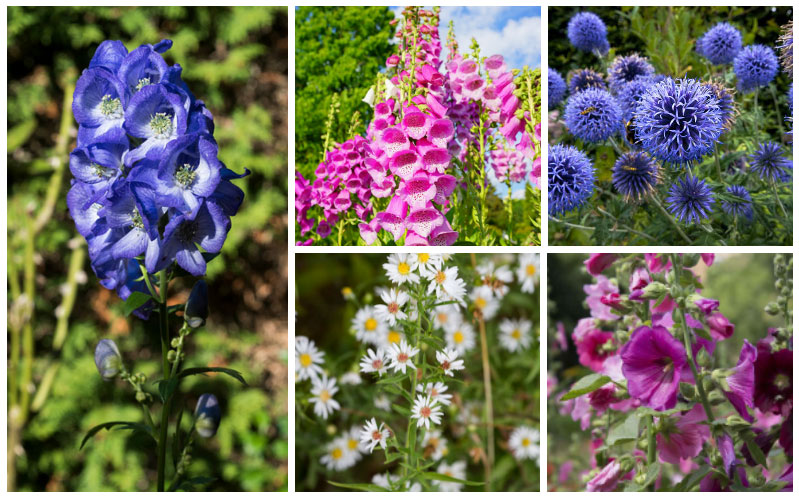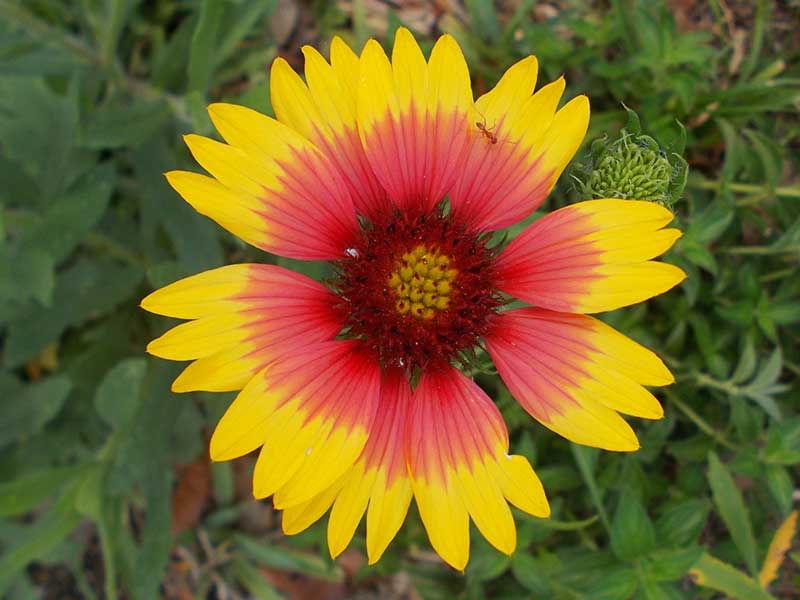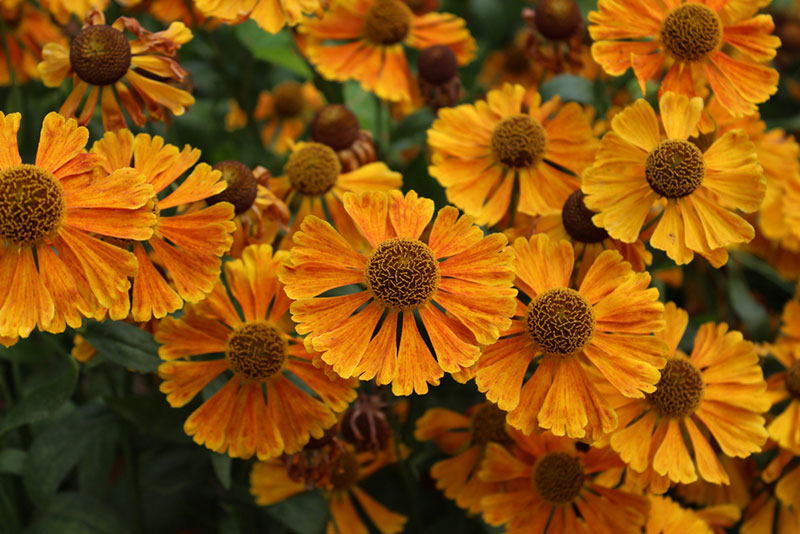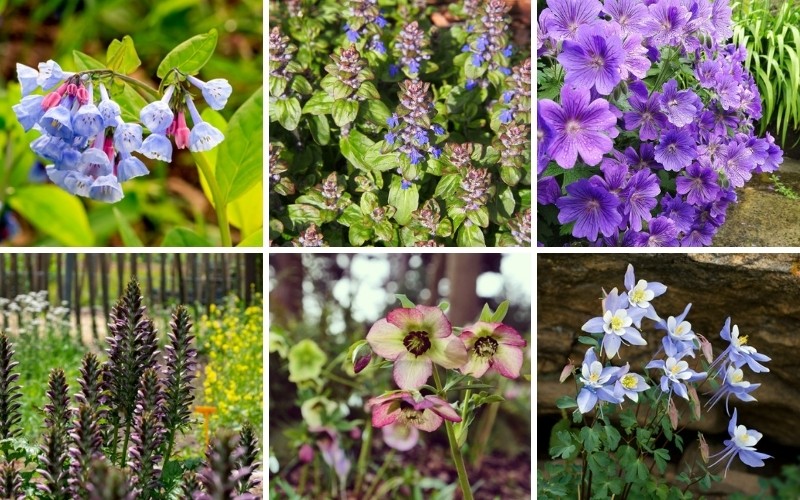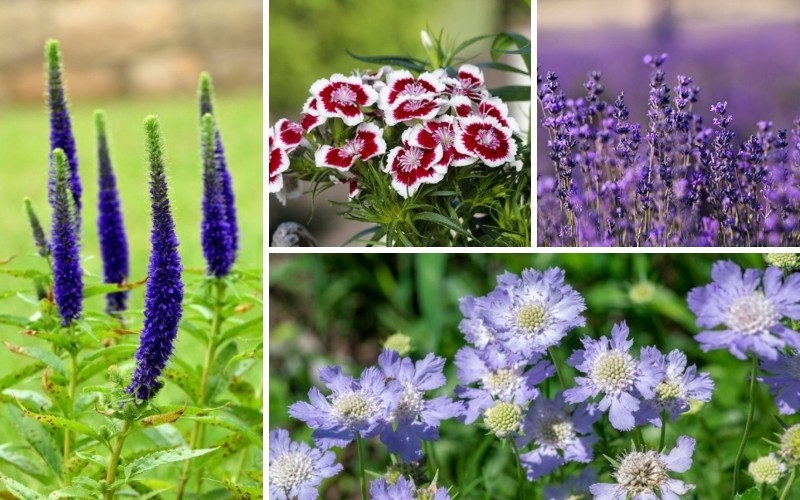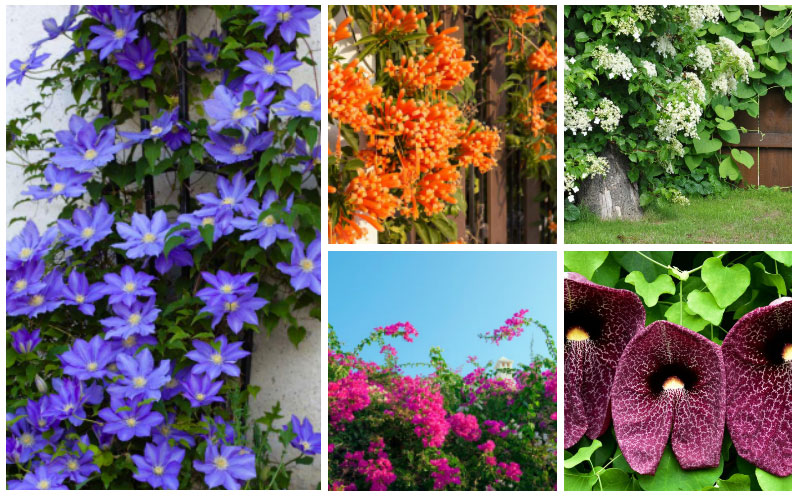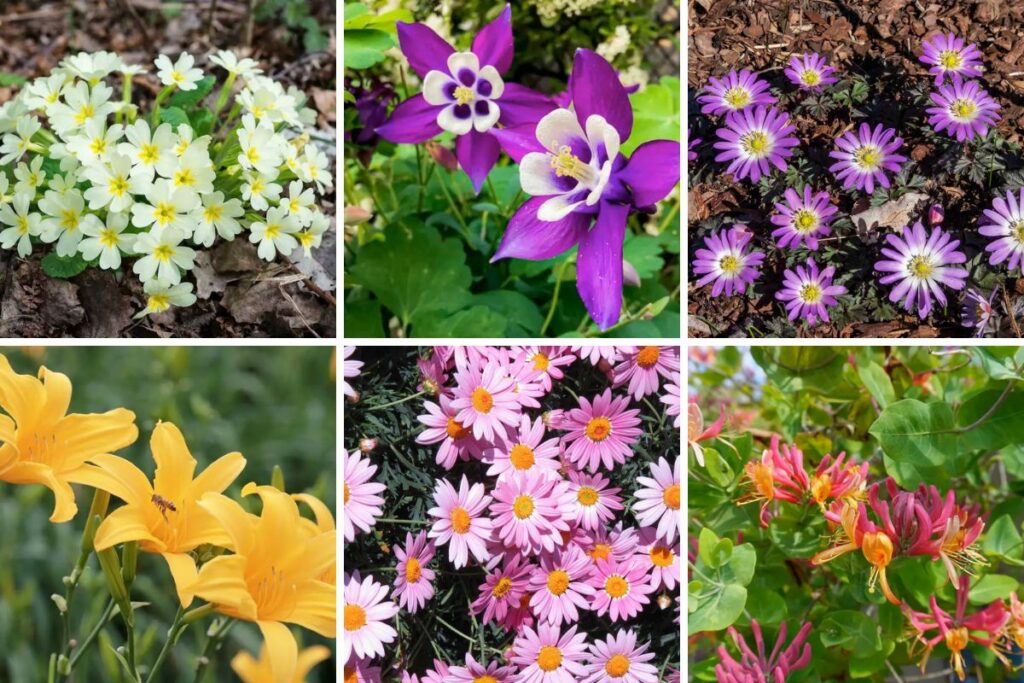
March marks the beginning of spring. The dreary winter season is almost over, and life starts to sprout from the ground again.
As spring is right around the corner, it’s the perfect time to start growing alluring flowers that’ll give your garden a splash of color.
If you don’t know where to start, we have plenty of ideas to spare. Here, we’ve listed 19 perennial flowers to plant in March and some quick care tips.
Without further ado, let’s get to our mini garden catalog.
1. Common Primroses
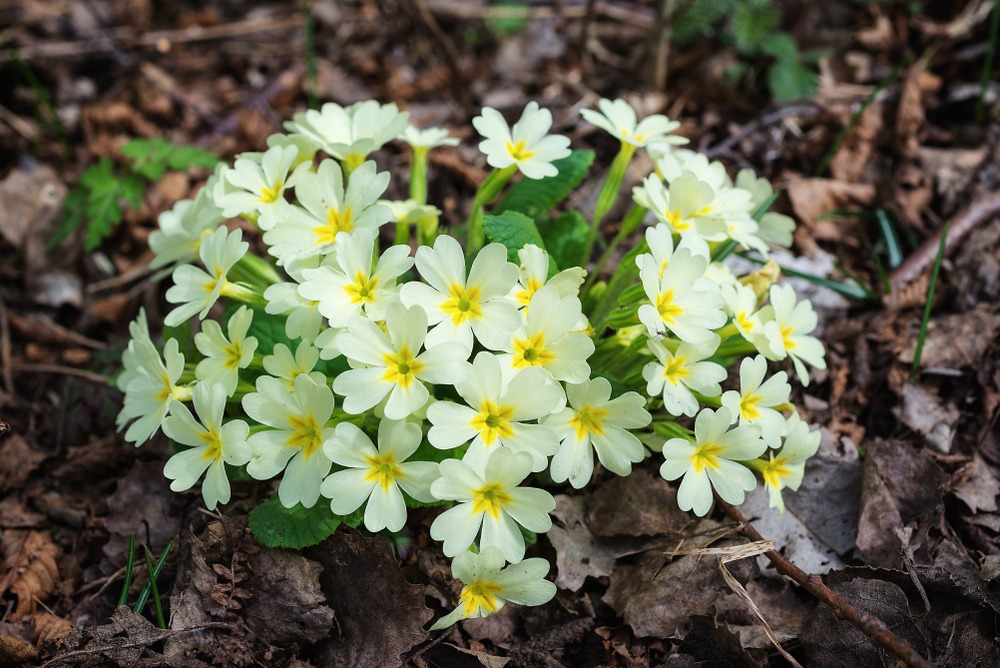
The distinctive feature of the common primrose is its large flower-heads with irresistible, multicolored petals. Their petals are available in color combinations like yellow-pink and sunny yellow-yellow.
Common primroses can grow up to 5.9 inches in height. Moreover, they can tolerate hardy zones four to eight, while some sources say zones four to nine. These flowers start blooming from early March to May.
When planting primroses, acidic, well-draining soil with humus is most suitable. At the same time, they should be planted in partly shaded areas.
2. Chrysanthemums
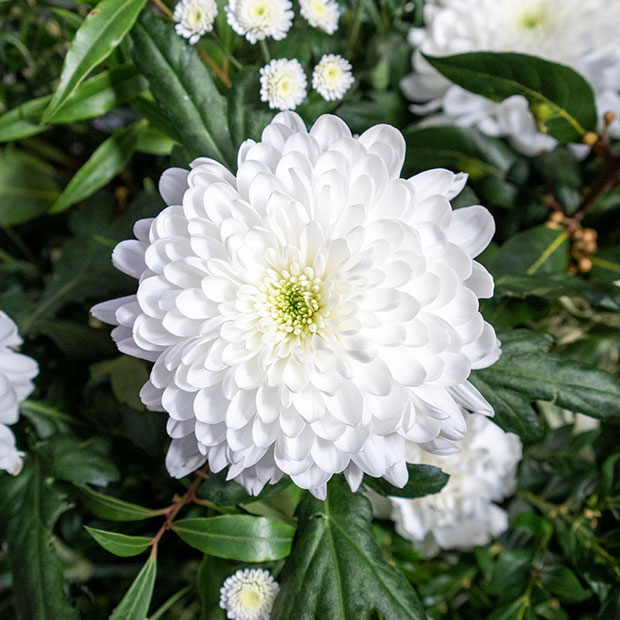
Chrysanthemums are herbaceous perennials that bloom from summer through fall. They have dark green leaves and flowers with striking colors.
Their flower heads have multiple layers of florets with colors that range from white and bright yellow to magenta and purple.
Most chrysanthemums are hardy in zones five to nine and start blooming in the summer. When it comes to length, chrysanthemums can be as tall as six feet.
Lastly, caring for chrysanthemums is simple. Plant them in well-draining soil and give them at least six hours of sunlight per day for optimal growth.
3. Columbines
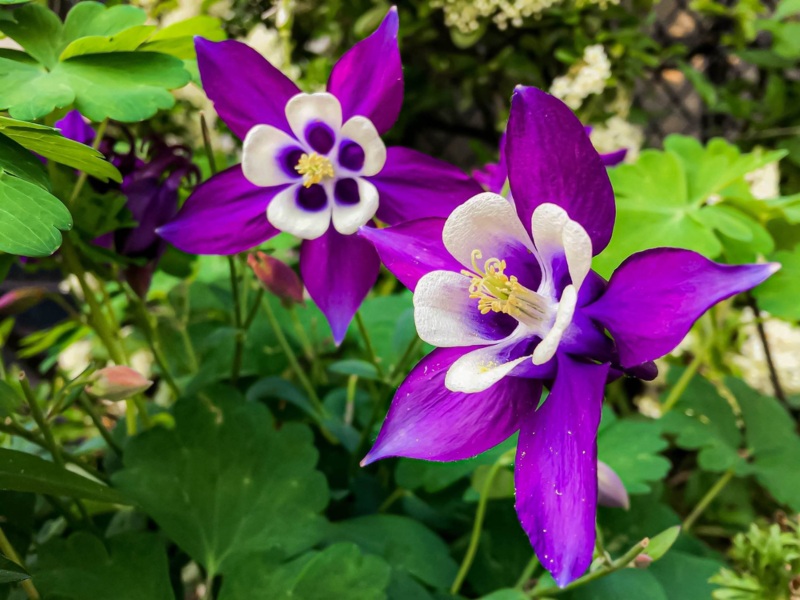
These flowers from the buttercup family have an attractive appearance. They have multicolored petals that sit atop their star-shaped sepals. So, they look like two flowers in one stem!
The columbine’s colors vary from yellow to lilac and red. They bloom in mid-spring and are hardy in zones three to nine.
Aside from their pretty appearance, they’re loved for being low-maintenance flowers. They don’t need much care, except you should only water them when the soil’s upper layer becomes completely dry. Moreover, they can tolerate neutral to acidic soil pH.
4. Daylilies
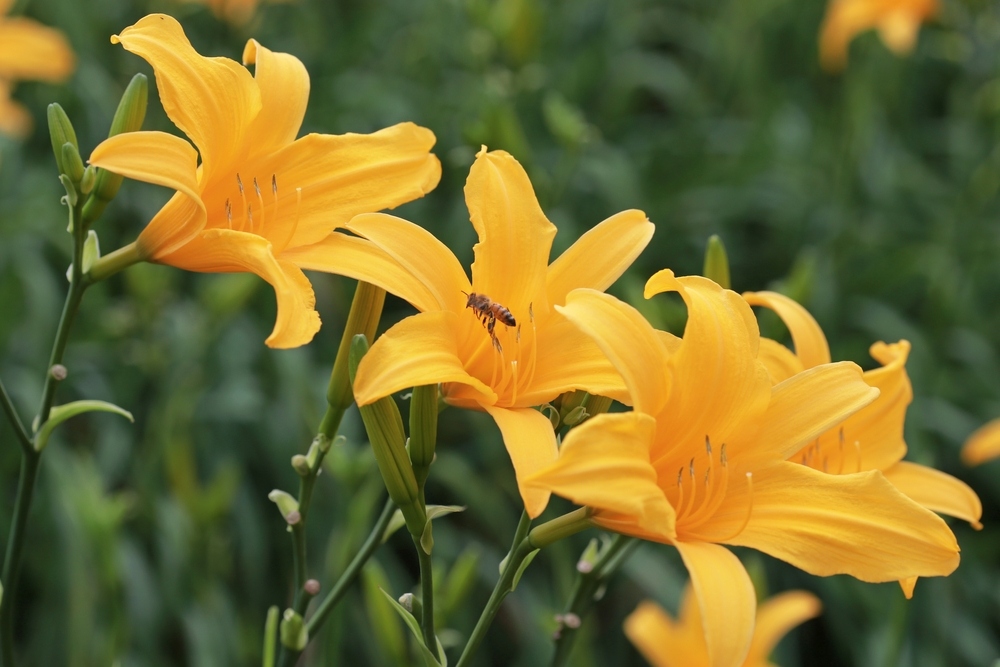
Daylilies are a great addition to your garden if you want beautiful but easy-to-care flowers. They’re regarded for their unique shapes and enthralling colors!
The shape of daylily petals varies from spider-like to wide with ruffle edges. Some variants are multicolored, while some are bright yellow and apricot.
Furthermore, daylilies are drought-resistant plants that survive even in poor soil conditions. They bloom in June and thrive best in zones four to nine.
Finally, weed daylilies regularly and water them once a week to improve their growth.
5. Bellflowers
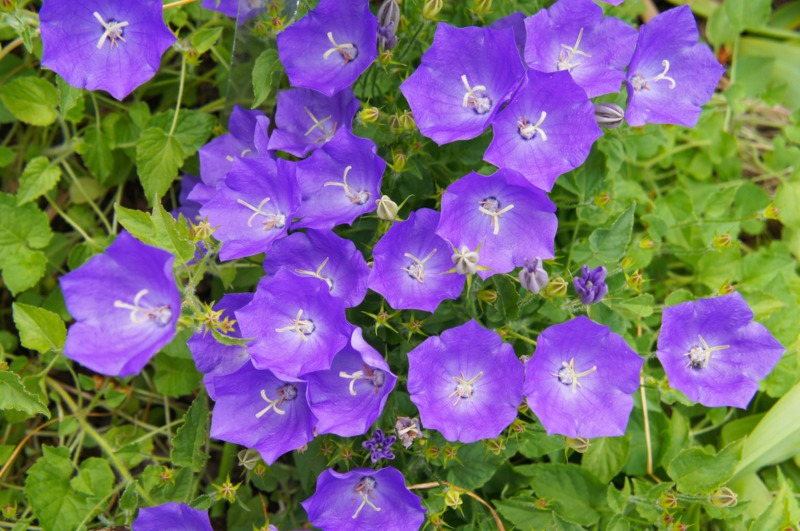
Bellflowers make excellent houseplants that are easy to grow. Consequently, some variants look beautiful as groundcovers.
Depending on the variant, these flowers are sometimes shaped like bells or stars. For their color, they’re mostly available in shades of purple and blue.
Additionally, they bloom in June and can grow up to one foot in height. They’re sun-loving perennials that thrive best in zones three to eight.
To care for bellflowers, plant them in moist, well-draining soil and water them once a week.
6. Hellebores
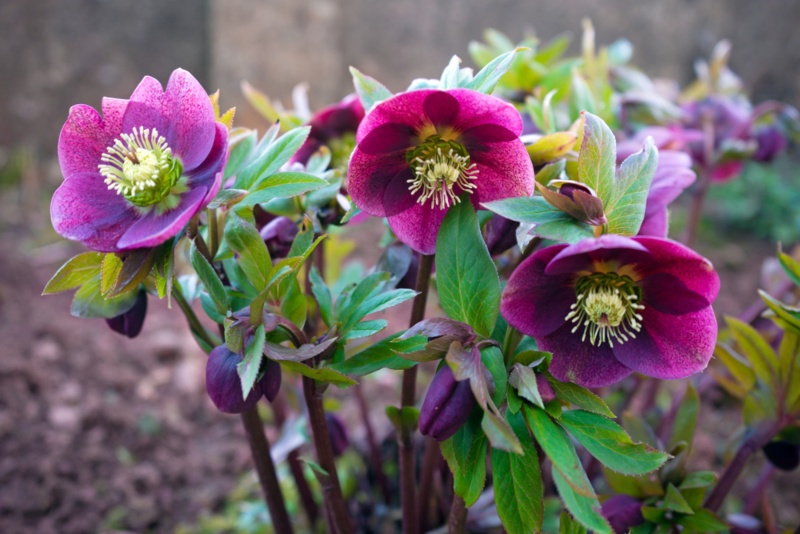
The actual petals of this plant are the small greenish nectaries located in its center. Its center is made up of nectaries along with small protrusions, called anthers and pistils.
Correspondingly, the sepals of these flowers are sometimes dotted or ruffled, with colors ranging from apricot to maroon.
However, the major drawback of planting hellebores is that they’re toxic, especially when swallowed. They can be irritating to the skin, too. That’s why they’re best planted outdoors or kept out of reach.
On the other hand, hellebores thrive in zones four to five and can reach up to 18 inches in height. While hellebores don’t require much care, they should be planted in well-draining, fertile soil.
7. Pyrethrum Daisy
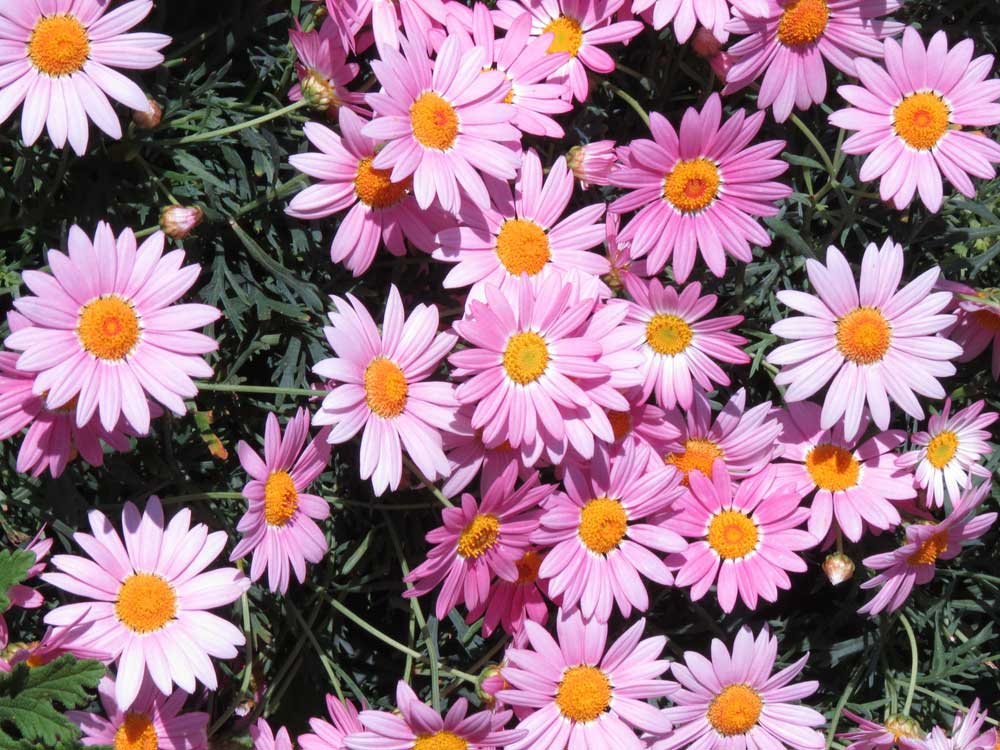
While daisies are available in several colors, the white-petalled ones with bright yellow centers are the most appealing. It’s because white daisies symbolize humility and purity. At the same time, it’s nice to have white flowers around, as they make you feel refreshed and calm.
These attractive flowers bloom in early summer and are hardy at zones four to ten (only some sources, though).
When it comes to planting daisies, partly shady areas are most favorable. Moreover, daisies thrive both in sandy and loamy soils. So, they only need to be watered once a week.
8. Grecian Windflowers
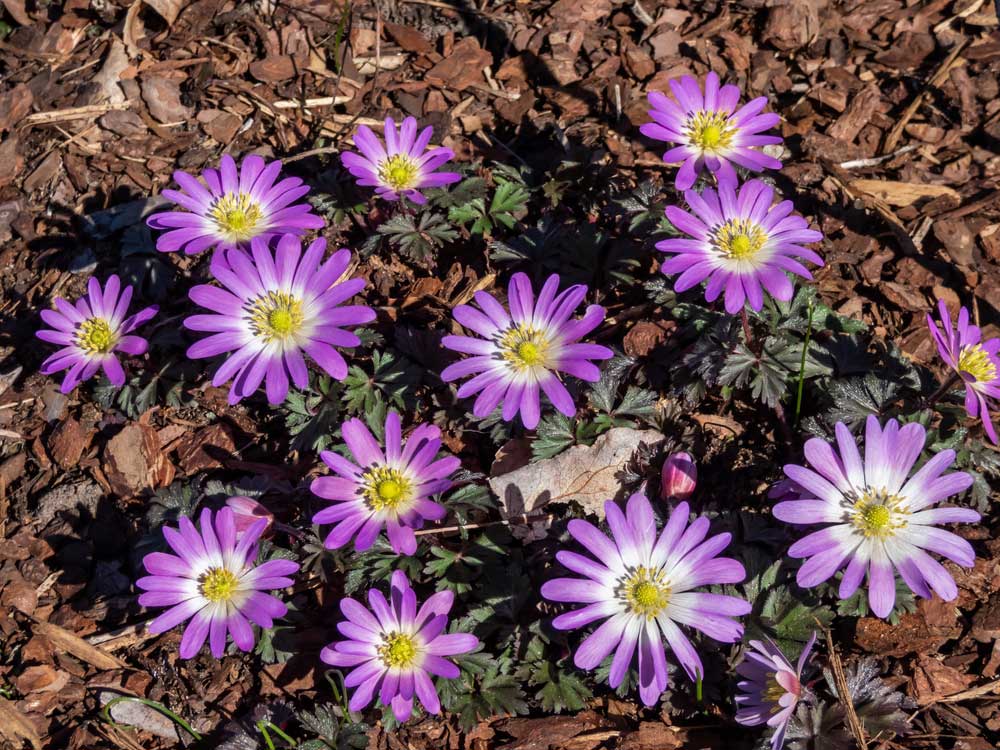
These daisy-like flowers are common in purple and lilac shades with some multicolored variants.
Similarly, Grecian windflowers bloom in April and make beautiful ground covers. When it comes to size, they can grow up to six inches tall.
One of the major advantages of growing these flowers is that they require minimal care and adapt well to different climate conditions. These flowers grow best in zones four to nine, so it’s better to plant them in rich, well-draining soil.
9. Calla Lilies
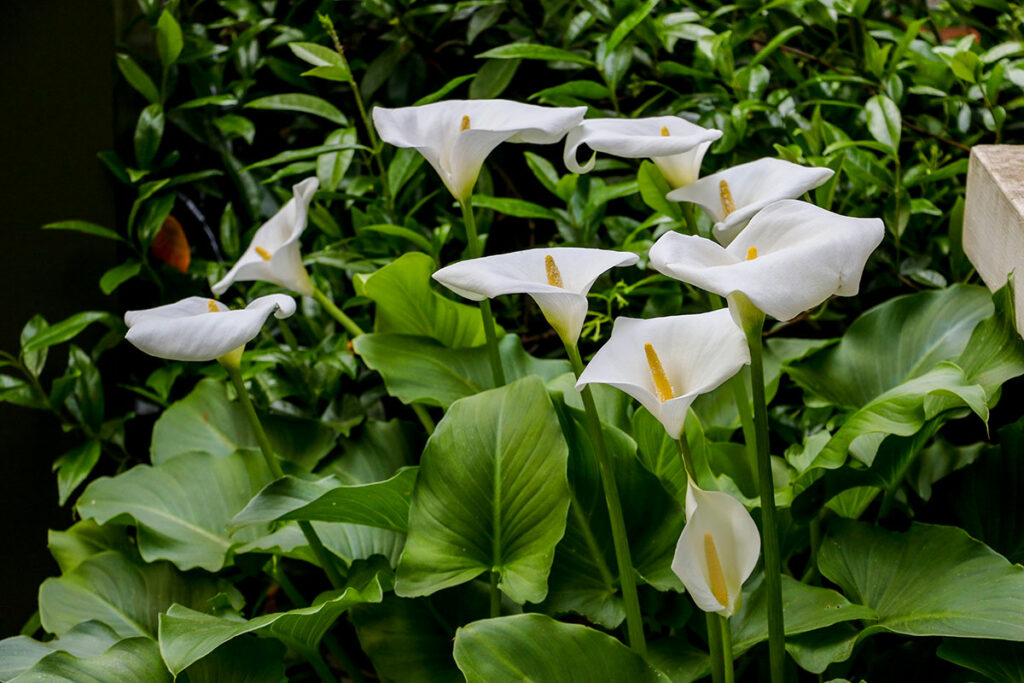
Among the perennials on our list, the calla lily has the most unique and striking appearance. These flowers have spathes that are sometimes heart-shaped or trumpet-like.
At the same time, they have finger-like, erect protrusions at the center called spadices.
Regarding colors, calla lilies are available in shades like champagne, peach, and orange. Interestingly, there are some with chromatic colors.
Calla lilies thrive best in moist, rich soil. However, avoid overwatering them, as this may lead to rots. They’re highly tolerant of the hot weather, too.
Lastly, calla lilies thrive best in zones eight to ten.
10. Honeysuckles
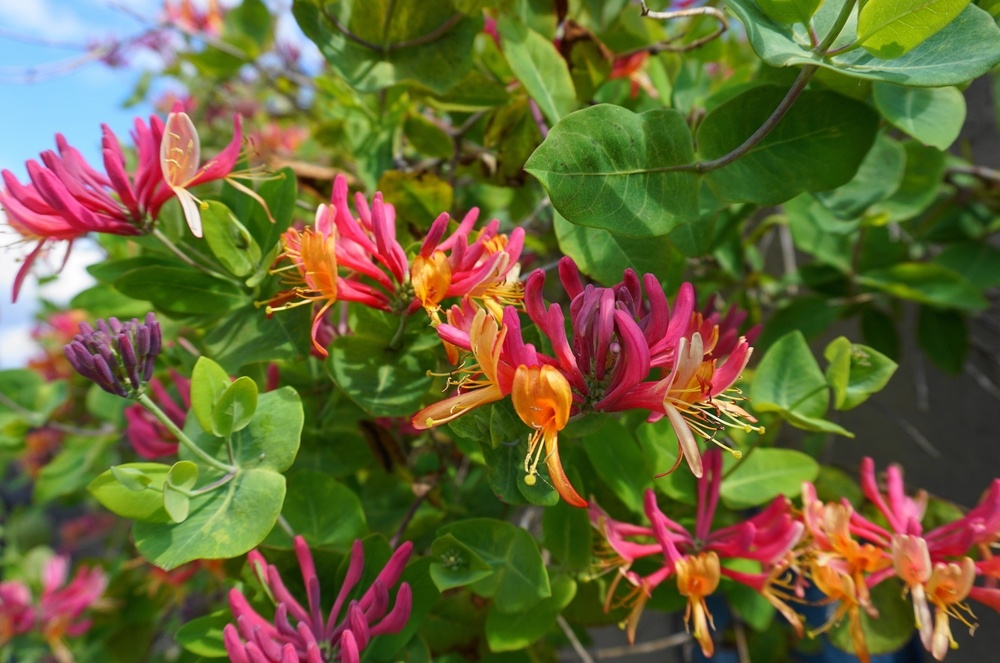
Here we have honeysuckles—known for their sweet scent that attracts many pollinators. These plants start displaying flowers in May and grow well in zones five to nine.
When it comes to appearance, honeysuckles have small, thin, and trumpet-like blooms that form clusters sometimes. These blooms are available in colors like creamy white and pink.
A general fertilizer is especially helpful if you want to grow more flowers. Pruning will help improve the appearance of your honeysuckles as well.
11. Lungwort (Pulmonaria)
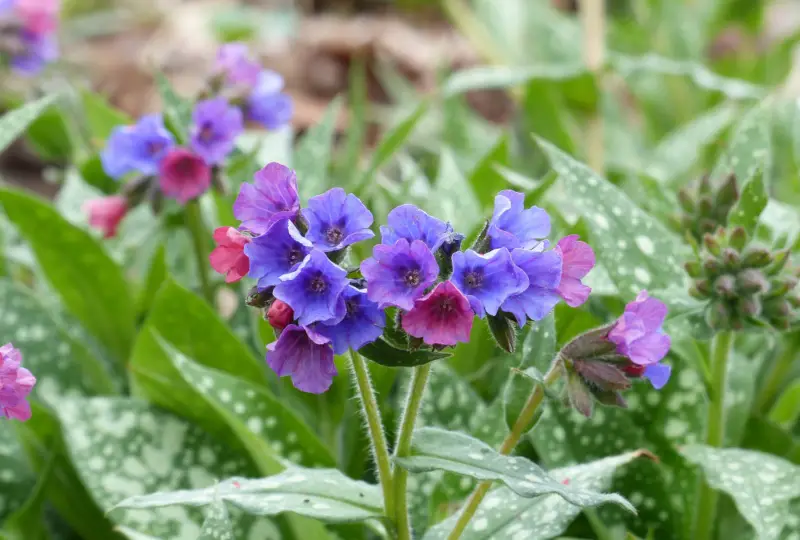
Lungwort brings early spring charm to shady spots in your garden. Its beautiful blue, pink, and purple flowers appear in early spring alongside tulips and other spring bulbs.
The fuzzy, speckled leaves create interest all season long. The spotted pattern on the leaves looks like tiny silver dots painted on dark green leaves.
This hardy perennial grows best in zones 3-8 and prefers shaded areas. Plant it under trees or along north-facing walls where it won’t get much direct sun.
Space your lungwort plants 1-2 feet apart when planting. The best time to plant is late summer or fall, though spring planting works too.
Your lungwort will need regular water, especially if planted under trees. The soil should stay moist but not waterlogged.
Use lungwort as a ground cover or in the front of shady borders. It pairs nicely with other shade-loving plants like hostas and ferns.
These plants typically live for 8-10 years with good care. They’re perfect for filling empty spots under trees or creating colorful spring displays in shaded areas.
12. Pasque Flower (Pulsatilla)
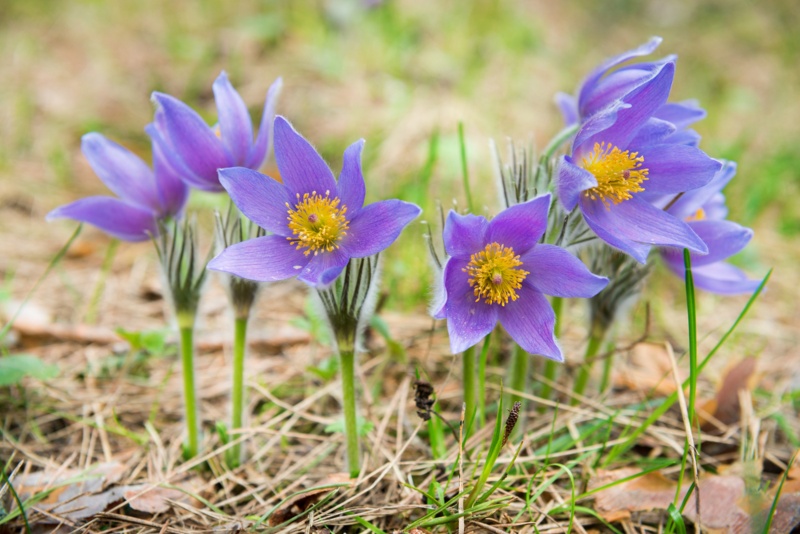
Looking to add early spring charm to your garden? The pasque flower blooms right around Easter, making it one of the first perennials to welcome warmer weather.
This clump-forming perennial grows 8-12 inches tall and wide. Its soft, fuzzy, gray-green foliage creates an attractive base for the delicate blooms.
You’ll love watching the flowers dance in spring breezes. The name “windflower” comes from this gentle swaying motion, which adds movement to rock gardens and borders.
Plant pasque flowers in full sun to partial shade. They adapt well to different light conditions but prefer spots where they can be easily noticed.
Important Note: The sap may irritate skin, so wear gloves when handling these plants.
Your pasque flowers will form neat mounds that won’t spread aggressively. The blooms appear in early spring, followed by interesting seedheads that extend the visual interest.
13. Creeping Phlox (Phlox subulata)
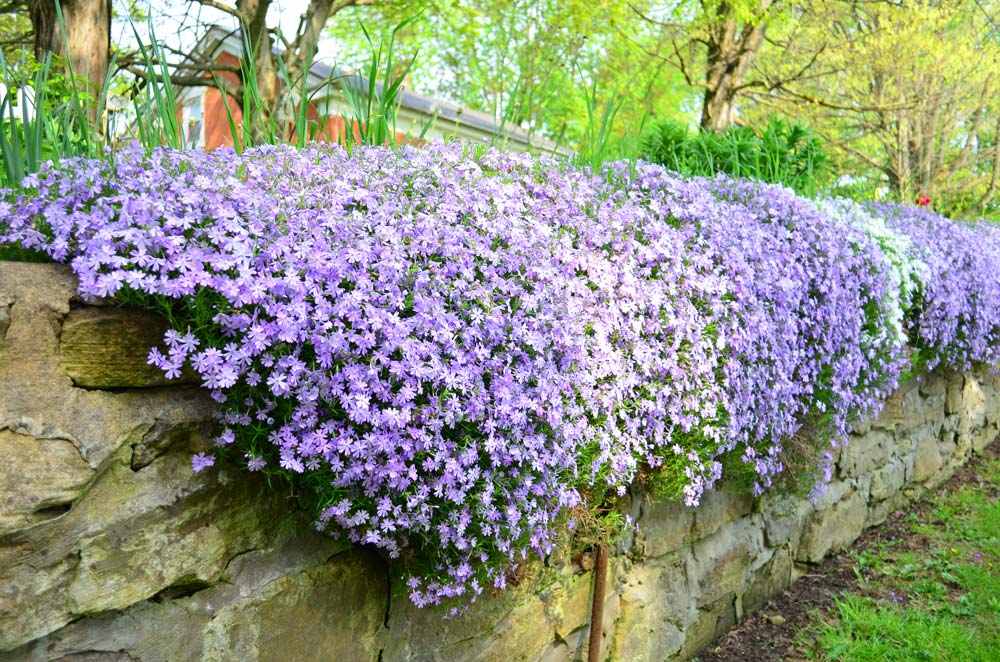
Creeping phlox brings a burst of color to your spring garden with its carpet-like spread of tiny flowers. This low-growing perennial reaches only 4-6 inches tall but spreads up to 2 feet wide, making it perfect for rock gardens and slopes.
You’ll love the variety of colors available – from pink and purple to white and blue. The flowers blanket the entire plant in mid-spring, creating a stunning display that lasts several weeks.
Plant your creeping phlox in full sun to get the best flowering results. It grows well in zones 3-9 and prefers well-draining soil.
This tough plant needs very little care once established. Water it regularly during its first growing season to help develop strong roots. After that, it becomes quite drought-tolerant.
Creeping phlox works great as a ground cover or border plant. Try planting it along walkways or letting it spill over retaining walls for a beautiful spring display.
Give this plant room to spread – it will fill in empty spaces quickly and help prevent weeds from growing. The evergreen foliage stays attractive even after the flowers fade.
14. Lenten Rose (Helleborus orientalis)
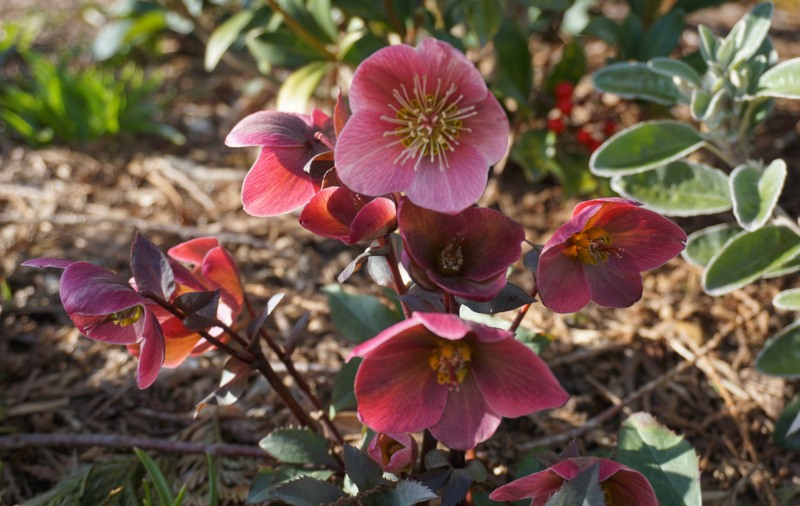
Lenten rose is a stunning perennial that brings color to your garden when most other plants are still dormant. Despite its name, it’s not actually a rose – it belongs to the buttercup family.
You’ll love how these flowers bloom from late winter through early spring, right around the Christian season of Lent. The cup-shaped blooms come in beautiful colors like white, purple, pink, green, and even black.
This hardy plant grows well in USDA zones 3-9 and reaches a height of 1-1.5 feet tall. It’s perfect for shady spots in your garden.
The evergreen foliage stays attractive all year, making Lenten rose a great choice for ground cover. The leathery leaves add texture to your garden even when the plant isn’t blooming.
Fun Feature: These early bloomers attract pollinators to your garden when few other flowers are available. The blooms last an incredibly long time – often up to 8-12 weeks.
Your Lenten roses will be happiest in rich, moist soil. Add a layer of mulch around the plants to keep roots cool and retain moisture.
These low-maintenance perennials rarely need dividing and can grow in the same spot for many years. They’re also deer-resistant and rabbit-resistant.
15. Candytuft (Iberis sempervirens)
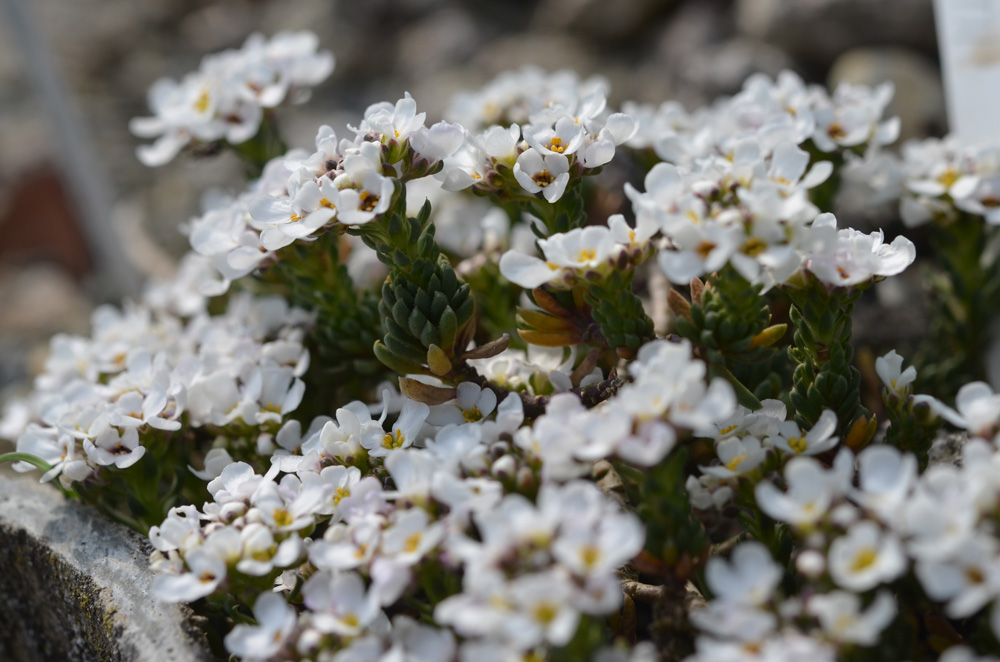
Candytuft brings charming white blooms to your garden from March through May. This hardy perennial creates a stunning ground cover that grows in neat, tidy mounds.
Your candytuft plants will reach 6-12 inches tall and spread 12-18 inches wide. The glossy, evergreen foliage stays attractive all year, making it perfect for edging pathways or garden borders.
Plant candytuft in full sun to partial shade. It grows best in well-draining soil and doesn’t need much water once established.
You’ll love how easy candytuft is to maintain. Simply trim back the plants after flowering to keep them neat and encourage more blooms.
For the best results, plant your candytuft in early fall. This gives the roots time to establish before the flowering season begins in spring.
These low-growing plants look great in rock gardens, along borders, or spilling over retaining walls. Their dense clusters of flowers attract butterflies and other pollinators to your garden.
16. Bleeding Heart (Dicentra spectabilis)
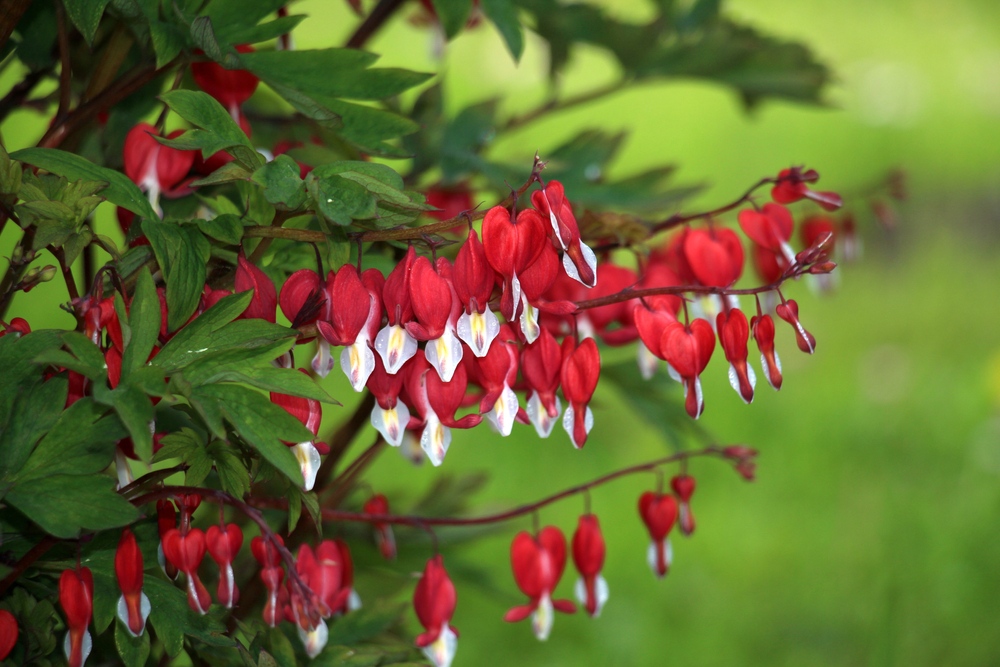
You’ll love adding this charming perennial to your shady garden spots. The heart-shaped pink and white flowers dangle like delicate jewels from arching stems in early spring.
This easy-care plant reaches 2-3 feet tall and wide. It grows best in cool, moist areas with partial to full shade.
Bleeding Hearts start emerging as soon as the soil warms in spring. The flowers bloom for several weeks, making them perfect for early-season color.
The foliage naturally dies back by mid-summer after blooming ends. Plan to pair it with later-blooming shade plants like hostas or ferns to fill the space.
You can grow Bleeding Hearts in containers too. Just make sure to use a pot at least 12 inches deep with drainage holes.
The white variety ‘Alba’ offers a lovely alternative to the classic pink form. Both types make beautiful cut flowers that last several days in a vase.
17. Coral Bells (Heuchera)
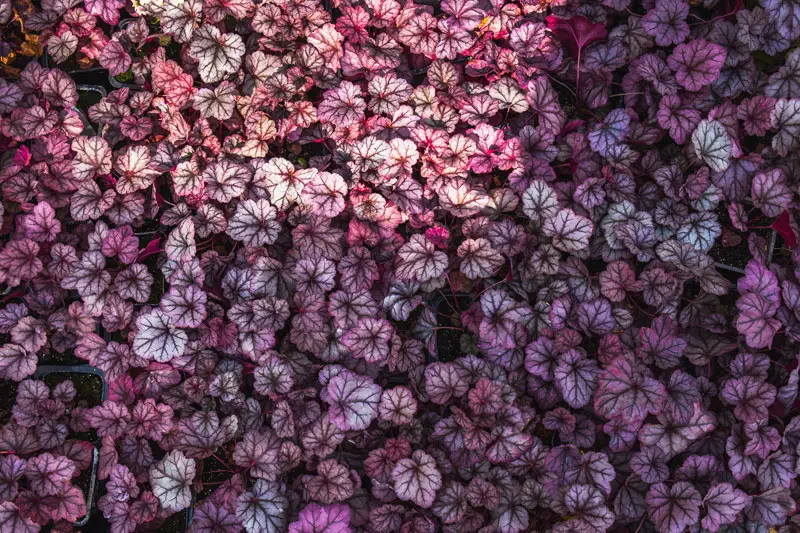
Coral bells make a perfect March planting choice for your garden. These easy-growing perennials thrive in zones 4-9 and adapt well to different conditions.
You’ll love the stunning foliage colors that coral bells offer. Their leaves come in shades of purple, lime green, bronze, and burgundy, adding year-round interest to your garden beds.
Plant your coral bells in bright shade for the best results. They also grow well in containers or ground plantings, giving you lots of flexibility.
These hardy plants resist both rabbits and deer, so you won’t need to worry about garden pests eating them. They’re also very low-maintenance and can handle poor soil.
The dainty bell-shaped flowers appear on tall stems in spring and summer. They attract butterflies and hummingbirds to your garden space.
You can expect your coral bells to stay evergreen in warm areas. In colder regions, they become semi-evergreen but bounce back each spring with fresh growth.
18. Woolly Thyme (Thymus pseudolanuginosus)
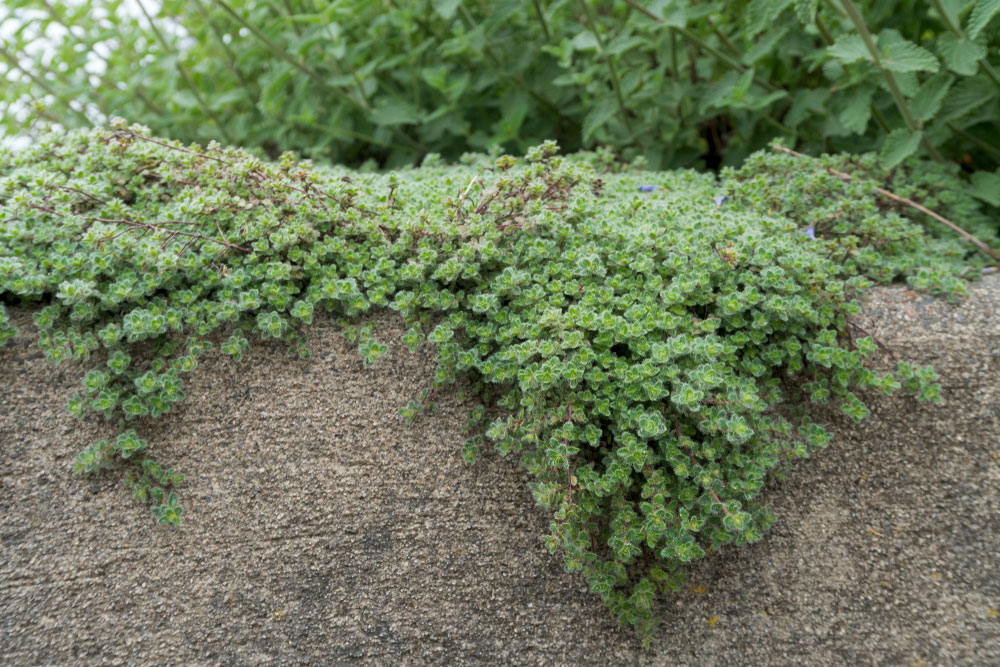
Woolly thyme makes a perfect addition to your March garden plans. This fuzzy-leaved ground cover creates a soft, carpet-like mat that spreads beautifully across your landscape.
Your woolly thyme will thrive in full sun to light shade. Plant it in well-drained soil – this easy-going plant actually prefers poor to average soil conditions.
This tough little plant can handle temperatures down to -20°F, making it a reliable choice for cold climates. The grey-green foliage stays evergreen in most areas.
Tiny pink flowers appear occasionally, bringing butterflies to your garden. While some thymes are used for cooking, woolly thyme’s leaves lack strong fragrance and aren’t meant for culinary use.
Give your plants enough space to spread, as they’ll form a dense mat over time. You can easily divide them in spring or fall to create more plants – even small pieces will root readily.
For best results, avoid planting in wet or soggy areas. Your woolly thyme will rot if the soil doesn’t drain well.
19. Hardy Geranium (Geranium spp.)
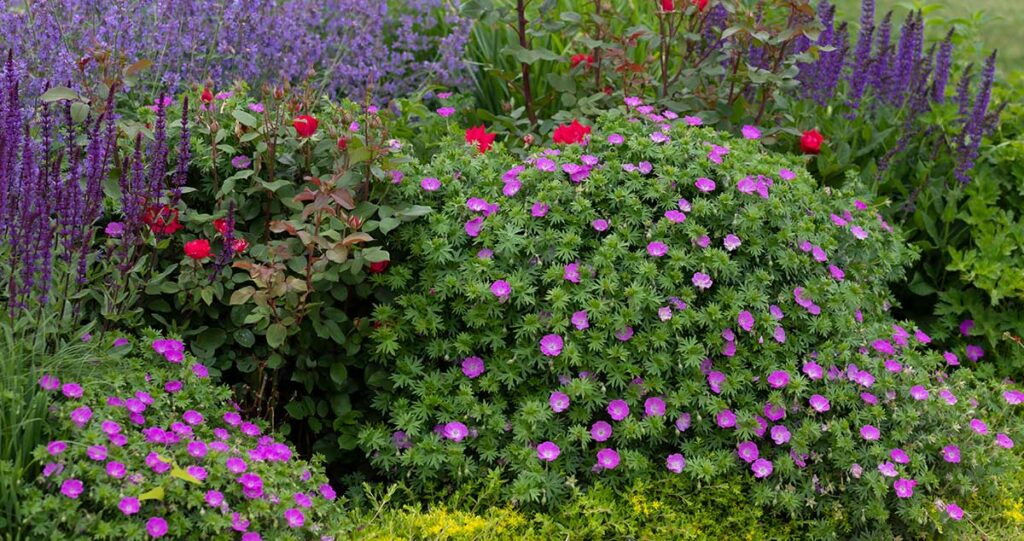
Hardy geraniums, also called cranesbill geraniums, bring long-lasting color to your garden. These tough perennials come back year after year and spread to create beautiful ground cover.
You can plant these easy-care flowers in March when the soil starts to warm up. They grow well in zones 4-8 and reach heights of 12-18 inches with a spread of 2-3 feet.
Hardy geraniums need very little care once established. They resist pests and diseases, making them perfect for busy gardeners.
Plant them in flower beds, rock gardens, or use them to fill empty spaces between other plants. Their pretty foliage adds texture to your garden even when they’re not blooming.
You’ll see flowers from May through June, and some varieties bloom again in fall. Cut back the plants after the first bloom to encourage more flowers.


